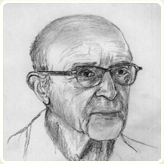 Sketch of Carl Rogers, a key figure in humanistic psychology. Sketch of Carl Rogers, a key figure in humanistic psychology.
| Time
| 1950s |
| Title
| Psychologist Carl Rogers introduces humanistic psychology |
| Event
| After an academic career of teaching and counseling, Carl Rogers emerges as a prominent figure in the humanistic school of psychology. Rogers is best known for his client-centered therapy, which suggests that the client should have as much impact on the direction of the therapy as the psychologist. His works include Client-Centered Therapy (1951) and On Becoming a Person (1961). |
|
Rogers’ research focuses on using open communication to empower individuals to achieve their full potential. He moves away from traditional psychoanalysis, and develops client-centered psychotherapy. Client-centered therapy sees non-judgmental attitudes and mutual respect as powerful tools. Rogers believes that the client has the answers. The therapist's job is to lead the client toward this self-knowledge. Specific assessment techniques and the therapist's opinion are considered unimportant in Rogers’ philosophy.
|
Good mental health is emphasized as a component of overall well-being, but Rogers does not specifically address bodily health and healing.
|
Rogers’ work is not overtly spiritual, but does underscore the transcendent power of human beings to make positive change.
|
|



